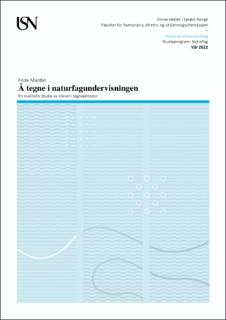| dc.contributor.advisor | Sjøberg, Mari | |
| dc.contributor.author | Mardal, Fride | |
| dc.date.accessioned | 2022-08-30T16:41:44Z | |
| dc.date.available | 2022-08-30T16:41:44Z | |
| dc.date.issued | 2022 | |
| dc.identifier | no.usn:wiseflow:6608086:50635306 | |
| dc.identifier.uri | https://hdl.handle.net/11250/3014470 | |
| dc.description | | |
| dc.description.abstract | Hensikten med denne studien er å undersøke muligheter og utfordringer knyttet til det å tegne i naturfag. Dette blir studert i en undervisningsøkt som der elevene skal tegne en modell av drivhuseffekten. Undervisningsopplegget er blitt planlagt av meg og naturfagslæreren for klassen. Planleggingen av undervisningen tar utgangspunkt i Tytler et al. (2013) sine prinsipper for representasjonsbasert undervisning. Denne masteroppgaven har som mål å belyse problemstillingen: hvilke utfordringer og muligheter er det når elever arbeider med å tegne modeller i naturfagundervisningen? For å samle inn data er det blitt brukt video- og observasjon og elevproduktene fra timen er blitt samlet inn. Studien er en kvalitativ utviklingsstudiet, der to elevgrupper sitt arbeid med å tegne en modell blir studert. Det er videre blitt gjennomført en interaksjonsanalyse av samtalene elevene hadde og en analyse av elevene sin tegneprosess.
Funnene fra studien viser at elevene har en utvikling av forståelsen i arbeid med tegningen. Utover i tegneprosessen har elevene mer og mer fokus på den naturvitenskaplige forklaringen. Dette gjelder både i samtalene til elevene og hvordan tegningen utvikler seg. Denne utviklinger skjer ved at elevene interagere med hverandre og tegningen, og dette fungerer som en drivkraft for å få komme videre i arbeidet. Videre viser funnene at elevene har vansker med å vite hvor de skal starte med modellen og hva de skal inkludere i modellen. Flere av elevene bruker også mye tid til å fargelegge tegningen sin. | |
| dc.description.abstract | This thesis aims to investigate the opportunities and challenges related to drawing in sciences. The research is conducted during a classroom activity where the students are asked to draw a model of the greenhouse effect. The teaching plan is planned by the author and the teacher of the natural science class and departs from Tytler et al. (2013) principles of teaching based on representations. This thesis aims to answer the following research question: which challenges and opportunities occurs when students work with drawing their own models in science classes? The empirical data gathering methods consist of video, observation, and the models made by the students during the class. The study is a qualitative development study, where the drawing of models by two different groups of students have been analyzed. Further, an interaction analysis of the conversations between students during the class and an analysis of the drawing process has been conducted.
The findings show that the students experience a development in their understanding when drawing. Furthermore, the study indicates that the students gain an increased focus on the scientific explanation. This development occurs through interaction between the students related to the drawing and acts as a driving force to move forward in their work. The study further shows that students experience struggles related to how they are supposed to start drawing the model and what they should include. A considerable portion of the students also spends a significant amount of time coloring their drawings. | |
| dc.language | nob | |
| dc.publisher | University of South-Eastern Norway | |
| dc.title | Å tegne i Naturfagsundervisningen | |
| dc.type | Master thesis | |
